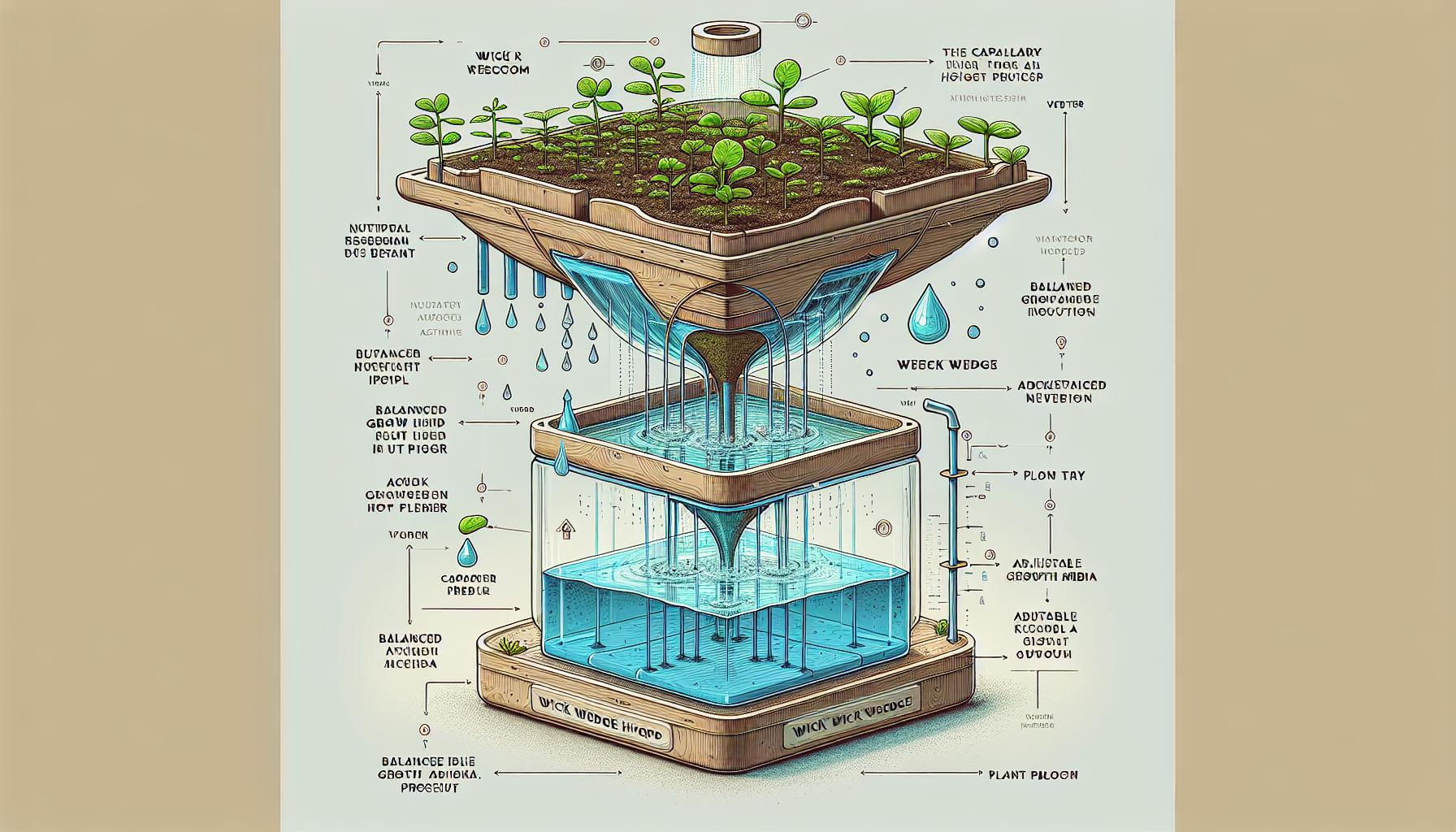Innovations in the realm of health-infused agriculture seep into every crevice of our day-to-day life, painting a vibrant picture of a future filled with sustainable and health-focused cultivation techniques. One such area that’s experiencing a fascinating revolution is the cultivation of ginger and turmeric - two powerful nodes of natural health often praised for their medicinal properties. In this blog post, we unfold the exciting journey of transforming traditional cultivation techniques into hi-tech, yet simple methodologies. Spurred by the teachings of the YouTube video ”Harvesting Health: Innovations in Ginger and Turmeric Cultivation,” we dive headfirst into the invigorating world of hydroponic and rain gutter growth systems. We aspire to bring an insightful discovery from the realms of YouTube to the written word, unravelling a growth protocol designed for life’s most coveted spices – ginger and turmeric. Let the journey begin in the harmonic marriage of technology, health, and agriculture.
Table of Contents
- Understanding the Hydroponics: An In-Depth Look into Rain Gutter Grow System
- The Art and Science of Hydroponic Ginger and Turmeric Cultivation
- Dissecting the Wick Wedge Hydroponic System: Innovations in Nutrient Delivery
- Pushing Boundaries: Redesigning the Wick Wedge System for Optimal Growth
- An Evolution in Cultivation: Present and Future Potential of Hydroponics in Ginger and Turmeric Cultivation.
- Q&A
- Final Thoughts
Understanding the Hydroponics: An In-Depth Look into Rain Gutter Grow System

When delving into the world of hydroponics, getting familiar with the many modern cultivation techniques is a must. Today, we look into the innovative Rain Gutter Grow System, a type of passive, non-electrical watering system for container plants in a soil system, which was developed by Larry Hall. This system employs gutters filled with water from a float valve, with containers situated over the top and a net cup extending from the container bottom. To ensure effective hydration, the soil medium is often supplemented with cocoa or peat moss, thus facilitating the wicking process and ensuring water is readily available to the plants.
The application of the Rain Gutter Grow System extends beyond traditional gardening methods and has been adapted for hydroponic use as well. Dr B A Krattkey, known for his invention of the Krattky technique, influenced such adaptation by replacing water channels with nutrient-rich hydroponic mediums. This process, consequently, allows the plants in soilless media to access necessary nutrients. Our focus in this write-up will primarily revolve around the Wick Wedge Hydroponic System, an efficient method for delivering nutrients to bagged media within a Rain Gutter Grow System environment. This design, briefly covered in one of our previous videos, can be created without 3D printing, making it a practical solution for gardeners on a budget.
The Art and Science of Hydroponic Ginger and Turmeric Cultivation

The intriguing practice of cultivating ginger and turmeric hydroponically involves a passive wicking auto refilling rain gutter system. For starters, it’s important to understand some terms. At the core of this system, we have the Rain Gutter Grow System Design, an ingenious method of passively watering container plants in a soil system, developed by Larry Hall. It employs gutters loaded with water from a float valve, with containers set over the top and a net cup jutting out from the base of the containers. To enhance water absorption, the soil is improved with cocoa or peat moss.
<table class="wp-block-table is-style-stripes">
<thead>
<tr>
<th><b>Term</b></th>
<th><b>Description</b></th>
</tr>
</thead>
<tbody>
<tr>
<td><b>Rain Gutter Grow System Design</b></td>
<td>An innovative method for passively watering container plants</td>
</tr>
<tr>
<td><b>Float valve</b></td>
<td>The device responsible for charging the gutters with water</td>
</tr>
</tbody>
</table>Dr. B A Krattkey, a well-known name in the field, adapted this rain gutter system to a hydroponics setup, replacing water with hydroponic nutrient communicated to the plants in soilless media. To devise a cost-effective yet efficient setup, we can utilize two different structures, the non-3D printed rain gutter system and the 3D printed wick wedge system. For those seeking to replicate this process, it’s recommended to use a compact, filament-conservative variant of the former, like the Growth Spike. Using this method, you can successfully start on your journey towards hydroponic cultivation of ginger and turmeric.
Dissecting the Wick Wedge Hydroponic System: Innovations in Nutrient Delivery

In diversifying hydroponic cultivation techniques, the Wick Wedge Hydroponic System comes at the forefront. This method ingeniously integrates the principles of the renowned Rain Gutter Grow System, initially designed by Larry Hall, and refines it for hydroponic application. Essentially, the system involves containers placed over gutters filled with hydroponic nutrients instead of soil or water. Each container has a net cup at the base, through which the nutrient solution is wicked up into soilless media, such as cocoa or peat moss, and made readily available to the plants.
The Wick Wedge system holds extensive potential for cultivating nutritious crops like turmeric and ginger. Relying on the passive, electricity-free method of a Rain Gutter Grow System, this setup provides an innovative approach to nutrient delivery in hydroponic farming. It utilizes easily printable 3D components, or alternatively, traditional non-3D materials, making it affordable and practical for various scales of cultivation. With this system, you can easily set up a grow bag system for ginger and turmeric, capitalizing on the high success rates akin to the Rain Gutter Grow System.
- Design: Wick Wedge Hydroponic System
- Key principle: Adapting Rain Gutter Grow System to Hydroponics
- Nutrient delivery: Via gutters filled with hydroponic nutrients
- Media: Soilless, e.g., cocoa or peat moss
- Application: Innovative growth for crops like ginger and turmeric
| Feature | Description |
|---|---|
| Method | Passive, electricity-free |
| Setup Components | 3D printable or non-3D |
| Cost | Budget-friendly |
| Scale | Flexible – suitable for various scales of cultivation |
Pushing Boundaries: Redesigning the Wick Wedge System for Optimal Growth

Innovative hydroponic techniques have seen ground-breaking activities in the cultivation of ginger and turmeric. Through the use of the Wick Wedge system and the Rain Gutter Grow System, it’s now possible to set up an auto-refilling, passive wicking hydroponic system. They are designed to optimal growth conditions for these essential spices.
- Rain Gutter Grow System: Developed by Larry Hall, this method provides a passive (no electricity required) watering solution for container-grown plants in a soil system. Special gutters filled with water from a float valve let containers placed on top access water, with a net cup protruding from their bottom. The soil media is amended with cocoa or peat moss to wick up and make the water readily available to the plants.
- Wick Wedge Hydroponic System: An effective technique that allows for nutrient delivery to bagged media within the Rain Gutter Grow System environment. It has been redesigned a number of times to maximize its efficiency, and can be made without requiring a 3D printer.
Some experts in hydroponic cultivation have adapted the Rain Gutter Grow System for use with hydroponic nutrient instead of water, making it an excellent system for soilless media. This adaption was first proposed by Dr. B.A Krattkey, renowned for his Krattkey Technique. In this optical growth environment, a hydroponically-adapted Rain Gutter Grow System works excellently with the Wick Wedge Hydroponic System, presenting an even more efficient process for growing Ginger and Turmeric.
| System | Advantages |
|---|---|
| Rain Gutter Grow System | Passively waters plants, no electricity required, cost-effective |
| Wick Wedge Hydroponic System | Delivers nutrients efficiently, flexible for various types of media, can be made without 3D printing |
An Evolution in Cultivation: Present and Future Potential of Hydroponics in Ginger and Turmeric Cultivation

The power of hydroponics in ginger and turmeric cultivation is gaining significant traction in the agricultural world, a change that brilliantly aims to revolutionize traditional farming practices. The cultivation of these crops using a passive wicking auto-refilling rain gutter grow system style hydroponic setup is a novel idea that deserves some recognition. This efficient and economical model has been the object of experimentation and adaptation by a few noteworthy individuals such as Larry Hall and Dr. B A Kratky.
Larry Hall pioneered the rain gutter grow system, a non-electric method of watering container plants with a soil system. This setup employs gutters filled with water from a float valve, with containers anchored above and a net cup hanging from the container’s base. The soil gets enhanced by either cocoa or peat moss to facilitate water wicking and provide the plants with unrestricted access to water. Dr. B A Kratky introduced the idea of utilizing the same model for hydroponics where hydroponic nutrient replaces water in the channels which is then supplied to the crops in soilless media, a variation of Larry Hall’s soil method.
- 3D printer technology and its role in constructing rain gutter grow system components within budget.
- Two revisions of the original Wick Wedge design for different application scenarios.
- The success story of growing crops like turmeric and ginger using this hydroponic technique.
Implementing a Wick Wedge Hydroponic system for ginger and turmeric cultivation is a transformation worth exploring. For enthusiasts without a 3D printer, consider a more accessible construction method. Both 3D printed and non-3D printed techniques have shown promising results, with a difference only in the design aspect and printing cost.
| Hydroponic Technique | 3D Printed | Non-3D Printed |
|---|---|---|
| Wick Wedge System | Yes | Yes |
| Rain Gutter System | Yes | Yes |
Since its inception a year and a half ago, the journey of hydroponic ginger and turmeric cultivation has shown tremendous growth and positive outcomes. It has proven quite successful in a rain gutter grow system, especially with crops like turmeric expanding prolifically in this setup. Overall, the adoption of this evolutionary cultivation method offers a promising future in achieving harvest health.
Q&A
Q: What is the primary content of the YouTube video “Harvesting Health: Innovations in Ginger and Turmeric Cultivation”?
A: The video primarily focuses on how to grow ginger and turmeric using a specialized hydroponic system known as the Rain Gutter Grow System.
Q: Can you briefly explain what the Rain Gutter Grow System is?
A: This system, developed by Larry Hall, uses gutters filled with water or hydroponic nutrient from a float valve. Normally, it utilizes containers placed above the gutter, with a soil media made with cocoa or peat moss in a net cup which protrudes out the bottom of the containers. This approach helps in wicking up and rendering the water available to the plants.
Q: Can the Rain Gutter Grow System technique be used with hydroponics?
A: Yes, this system was adapted for hydroponics by Dr B A Kratkey, making it possible to use soilless media. Instead of water, the gutter channels are filled with hydroponic nutrients that are readily available to the plants.
Q: The video mentioned 3D printed components. What role do they play in this system?
A: The video describes the use of both non-3D printed and 3D printed components in the Rain Gutter Grow System. The channel has videos showing how these systems can be created without 3D prints. The 3D printed components can reduce the cost of the entire setup and be easily produced by those who have a 3D printer.
Q: What is the Wick Wedge hydroponic system mentioned in the video?
A: The Wick Wedge system is another method of delivering nutrients to bagged media within a Rain Gutter Grow System environment. It’s a 3D printable component but the video also offers a method of doing it without a 3D printer. There have been two redesigns of the Wick Wedge since its inception, including a more filament-efficient version called ‘growth spike’.
Q: What is the presenter’s experience with the Rain Gutter Grow System?
A: According to the video, the presenter had significant success with the Rain Gutter Grow System and has been using it for about one and a half years to grow ginger and turmeric. This largely influenced his decision to set up this type of grow bag system.
Final Thoughts
And there we have it – a journey through the landscape of innovative cultivation practices for ginger and turmeric. We immersed ourselves in the world of hydroponics, delved deep into the revolutionary rain gutter grow system, glanced at different techniques like the wick wedge system, and discussed adaptations by industry pioneers. Adapting these modern methods can surely optimize the cultivation of naturally health beneficial plants like ginger and turmeric, even in our own backyards. Keep in mind the techniques discussed are not limited to these crops. So why not take the plunge and let your gardening venture bloom with the vigor of hydroponics? As we say goodbye, do remember, every stint at cultivation is a step closer to nurturing a healthier self. Happy farming!

